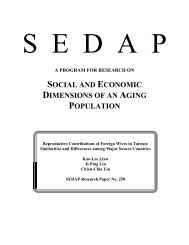Survey Results of the New Health Care Worker Study: Implications ...
Survey Results of the New Health Care Worker Study: Implications ...
Survey Results of the New Health Care Worker Study: Implications ...
- No tags were found...
Create successful ePaper yourself
Turn your PDF publications into a flip-book with our unique Google optimized e-Paper software.
48commitment scale is a measure <strong>of</strong> attitudinal commitment focusing on <strong>the</strong> process by whichpeople come to think about <strong>the</strong>ir relationships with <strong>the</strong> organization (Meyer & Allen 1997).Strong commitment, i.e. strong positive attitude towards <strong>the</strong> employing organization, is highlyassociated with <strong>the</strong> desirable organizational outcomes <strong>of</strong> lower absenteeism and turnover.Commitment is <strong>of</strong>ten referred in workplaces as allegiance, loyalty or attachment. Theorganizational commitment scale <strong>of</strong> Meyer, Allen & Smith consists <strong>of</strong> three components:affective commitment, continuance commitment and normative commitment.Affectivecommitment refers to <strong>the</strong> nurse's emotional attachment to, identification with, and involvementin <strong>the</strong> hospital. A strong affective commitment shows an emotional commitment to <strong>the</strong> hospital.Continuance commitment refers to <strong>the</strong> nurse's awareness <strong>of</strong> <strong>the</strong> costs that might be associatedwith leaving <strong>the</strong> hospital. They are committed to <strong>the</strong> hospital because <strong>the</strong>y believe that <strong>the</strong>y haveno o<strong>the</strong>r employment options. Lastly, normative commitment shows <strong>the</strong> feeling <strong>of</strong> obligation to<strong>the</strong> hospital to continue employment. High normative commitment scores show <strong>the</strong> nurses’attitudes that <strong>the</strong>y feel obligated to stay with <strong>the</strong> hospital and continue to provide care to patients.Each component <strong>of</strong> <strong>the</strong> scale consist <strong>of</strong> 6 items, scored on a 5-point scale with 1=strongly disagree to 5= strongly agree. The scale range is between 6 and 30 for each componentwith higher scores indicating higher organizational commitment. As presented in Table 28, <strong>the</strong>average for affective commitment was 17.7 (SD = 4.5), and Cronbach’s alpha = .82; forcontinuance commitment <strong>the</strong> mean was 17.9 (SD = 4.1) with Cronbach’s alpha= .72, and fornormative commitment <strong>the</strong> mean was 15.7 (SD = 4.4) and Cronbach’s alpha = .83. All threealphas were sufficiently high indicating a good internal reliability <strong>of</strong> <strong>the</strong> three components <strong>of</strong> <strong>the</strong>organizational commitment scale.








